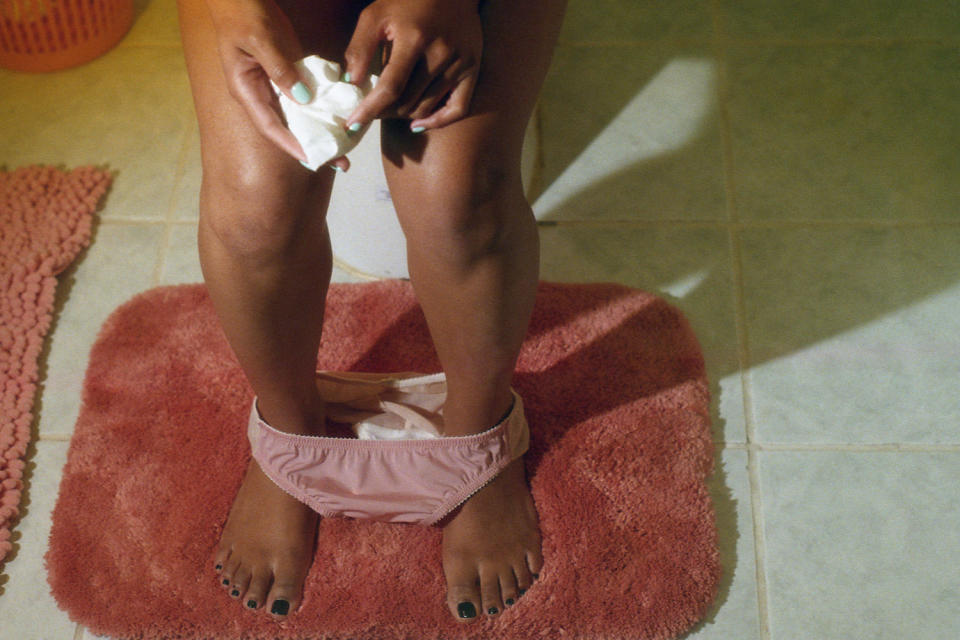Here's Some Sex Education You Actually Need — Including How Much Porn Is Too Much and Whether You Really Need to Pee After Sex
Sometimes the sex education we learn around the world isn't, well, that educational. So we've spoken to sex educators, doctors, and medical experts of all kinds to compile some information we think everyone should have access to. This list is not exhaustive, and will probably always need adding onto, so feel free to let us know what you may still be curious about at the end!

1.Virginity is not really a thing. Relying on someone's hymen to determine whether or not they are considered a "virgin" is wildly misleading and, according to Dr. Diane Horvath (MD, MPH), also based on a patriarchal fairy tale that a penis is so powerful it can change who a person is.

Hymens are real but their ability to indicate “virginity” is not. Dr. Horvath explains that hymens are thin pieces of tissue inside the vaginal opening that are typically seen before puberty. She continued, "When estrogen levels increase in puberty, the hymen becomes stretchy and most often just disappears on its own from things like using tampons, horseback riding, biking, masturbation, and sometimes from penetrative sex. Exams to establish 'virginity' by looking for an intact hymen are degrading and wildly inaccurate."
Likewise many people do not bleed after their first experience with penetrative sex so that’s not a marker for virginity either. Dr. Horvath stresses us all to remember that while sex can be life-changing, exciting, pleasurable, disappointing, fun, comforting, and a million other things, the idea that something is “lost” when you have sex for the first time is deeply misogynistic and harmful.
2.Birth control pills are not the only form of birth control on the market. Dr. Horvath likes to think about birth control in three categories: things that you use at the time you have sex, things that you have to take every day/week/month, and things that work over the long term.

Dr. Horvath continues, "If you only want to think about birth control right before you have sex, your options are condoms, withdrawal (pulling out), diaphragm/cervical cap, spermicides (like gel or foam), or a prescription vaginal gel that is similar to a spermicide." The advantage to these options is that they’re relatively easy to get (though you need a prescription for diaphragms, cervical caps, internal condoms, and vaginal gel), contain no hormones, and are completely controlled by you or your partner. Condoms are also useful for protecting against STIs. Some of the potential disadvantages are that insurance doesn’t usually cover them, they are generally less effective than things like pills or IUDs, and you have to remember to use them every single time you have sex.
3.Dr. Horvath continues that things you take daily/weekly/monthly for birth control purposes include hormonal contraception like pills, patches, and vaginal rings. You’ll generally need a prescription for these, though there are online telehealth services that don’t require an in-person exam. And, Dr. Horvath adds, "Some states allow pharmacists to dispense these products, so it’s worth checking to see if that applies to where you live."

Some advantages are that these methods are 90% or more effective, are often covered by insurance, and can help with things like heavy or painful periods. You can even use some of these methods to safely skip periods entirely. Possible disadvantages can include side effects related to hormones (bloating, mood changes, decreased sex drive), the need for a prescription, out-of-pocket cost, and lack of protection from sexually transmitted infections. Also it’s important to note that people with medical conditions like high blood pressure. or smokers age 35 or older may have some safety limitations on certain types of hormonal birth control.
4.The last main category of birth control, according to Dr. Horvath, includes things that are effective for months, years, or even permanently. The shot, an IUD, or more permanent surgical options are examples of this.

The birth control injection works for three months and usually requires in-person visits, says Dr. Horvath. She continued, telling BuzzFeed, "This option is considered highly effective but can be associated with weight gain or irregular bleeding in some cases. IUDs and implants must be placed and removed by a healthcare provider and can be expensive if you don’t have insurance, but have the advantage of being extremely effective without a lot of work on your end. Permanent birth control, like tubal ligation or vasectomy, is very reliable but NOT for people who think they might want more children in the future. Sterilization reversal surgery is expensive and almost never covered by insurance, so it’s important to be 100% sure about the decision to be sterilized."
5.Let's get to the bottom of squirting once and for all. Most experts seem to think that "cumming" — if you will — and squirting are two different things: squirting is the release of clear, watery fluid from the bladder through the urethra, sometimes up to 10 tablespoons. And vaginal ejaculation is thought to be from a structure called the Skene’s gland which is located under the urethra.

We again spoke to Dr. Diane Horvath (MD, MPH) to get more info on squirting. Dr. Horvath points out that like so many other things related to sexual function in people with vaginas/vulvas, squirting and female ejaculation are not as well understood as they should be. As mentioned above, most experts seem to agree that ejaculation and squirting are two different things. To recap; squirting is the release of clear, watery fluid from the bladder through the urethra, sometimes up to 10 tablespoons. Female ejaculation is thought to be from a structure called the Skene’s gland which is located under the urethra.
6.And, according to Dr. Horvath, the fluid from female ejaculation is usually thicker and whitish, and there’s less of it — typically up to a tablespoon.

Dr. Horvath continued, "Both squirting and ejaculation can happen during orgasm, but an orgasm isn’t necessarily required. Both squirting and ejaculation are perfectly normal, but most studies show that 50% or less of people with vaginas experience either squirting or ejaculation or both, so don’t stress yourself out if you don’t experience either phenomenon!"
And, Dr. Horvath stresses that It’s important to distinguish squirting and ejaculation from something called coital incontinence, which is when someone leaks urine during sex. This can happen with certain kinds of urinary disorders and should be evaluated by a medical provider!
7.STIs are often part of having sex, and they’re nothing to be ashamed of!!!! You wouldn’t be embarrassed to catch a cold at work, school, or a party, and likewise you shouldn’t be ashamed of catching an STI.

In fact, according to Emily Rymland, DNP, FNP-C, AAHIVS-certified HIV specialist and Director of Clinical Operations for Nurx, there’s NO shame in having an STI — if you have an active sex life you’ll probably get something at some point. But, she continued, "It is your responsibility to yourself and others to get tested regularly, and get treatment if you have a positive result. And to notify your partners so that they can get tested and treated as well."
8.Seriously, STIs are common. We're talking, like, 1 in 5 people currently have an STI, though many may not even know it. And about half of new STIs are acquired by people ages 15–24.

According to Emily Rymland, part of this is because many STIs are asymptomatic, meaning no symptoms are present, therefore you may have one and not know it. It’s nobody’s fault, that’s just the way it is with STIs! And it's important to keep in mind that there is a broad range of STIs. That's why regular testing can be crucial. Rymland wants people to understand that regular STI testing is routine self-care, and should be done at least annually if you are sexually active and not 100% certain of your partners’ status. Many people should get tested more than annually, if they have multiple partners. Having multiple partners does not make you a bad person, or mean you are doing literally anything wrong, it just means that you should screen more often — every three, six or 12 months depending on your lifestyle.
9.Some STIs, like herpes, are incurable but mostly harmless (if annoying). Others, like syphilis, are curable but can be dangerous if left untreated according to Rymland.

Many are “silent,” meaning they have few or no symptoms. Don’t stress too much about STIs, but do understand your risk factors, get tested regularly, and take prevention measures such as using condoms and/or taking PrEP.
10.Ok, so STIs are oftentimes asymptomatic, but there are some symptoms that people should be on the lookout for. According to Rymland, these include any changes in your genital region; like painful urination, pelvic pain, unusual discharge, or odors.

In addition, at times STIs can cause a sore throat or lesions in the mouth, and syphilis often at first causes a painless sore in the genitals or mouth that can go completely unnoticed, and the next symptoms is a generalized body rash that is often associated with rashes on palms and soles of feet. Basically any new pain or unusual symptoms should be checked out. But whether or not you have symptoms, get tested regularly. Rymland continues, "Many STIs can have serious consequences if they go unchecked, but they’re all treatable — even HIV is now a manageable condition that requires just one pill a day. There’s nothing to fear about knowing your status. The sooner you know your status the sooner you have control over your health and your body."
11.In terms of testing for STIs, unfortunately you may not be able to rely on your primary care provider or gynecologist to give you comprehensive testing — many don’t test unless you explicitly ask for it, or only test for chlamydia and things that affect fertility.

So, with that being the case, Rymland notes that you should always ask for the following if you are trying to determine whether or not you may have an STI: 1) A blood test for HIV and syphilis 2) A vaginal swab or urine test for urethral STIs, and 3) A throat and rectal swab for STIs like chlamydia and gonorrhea. If you have an STI in your throat or rectum it won’t show up on a urine test. If you’re at risk for one STI you’re at risk for all of them, so comprehensive testing is crucial. And, just so you know, Nurx offers three-site testing you can do at home with their Full Control STI Home Test Kit.
12.And, by the way, it's worth noting that there are some STIs that can be transmitted through saliva.

These include herpes simplex virus, syphilis, cytomegalovirus, and human papillomavirus. Many STIs can also be spread through oral sex. These include chlamydia, gonorrhea, syphilis, herpes, HPV, and trichomoniasis.
And it is important to note that STIs are not always transmitted from an infected person to an uninfected person. The rate of transmission, according to Rymland, depends on several factors, including the type of STI and the type of sex acts, among other factors. Some STIs — including chlamydia, gonorrhea, and syphilis — are curable with treatment. When somebody with HIV is on treatment and the HIV is undetectable, they cannot transmit it to a partner. When somebody with herpes takes antiviral medication daily, and avoids sex during any outbreaks, they are much less likely to transmit it, according to doctors affiliated with Nurx.
13.And remember, some STIs can be passed through oral sex, as well as through toys, so sexually active people should consider using dental dams for oral sex and condoms or other protective barriers on any shared toys. You should also clean toys regularly!

To see even more questions about STIs previously answered by Dr. Jennifer Peña, check out this article!
14.In terms of periods, there’s a pretty wide range of normal when it comes to periods, and according to Dr. Horvath, what’s normal for any one person can change throughout their lifetime. And no, severe pain during your cycle isn't normal and shouldn't be brushed off!

Dr. Horvath breaks it down even further for us explaining, "While an average cycle length is about 28–30 days, anything between 21 and 35 days is considered 'normal.'" If your cycle length is longer than 35 days, particularly if you have a period less than every 3 months, it’s something to discuss with your healthcare provider. Periods that last more than 7 days, especially when flow is heavy for more than the first 2–3 days, are a cause for concern. Likewise if your flow is so heavy that you are soaking through your pad or tampon or filling up your menstrual cup and leaking on to your clothes, that may be a sign of abnormally heavy periods that can cause anemia over time. She continues, adding, "Blood loss from periods is the most common cause of anemia in menstruating people. Bleeding between periods is also something to bring to your healthcare provider’s attention."
15.And remember, while it can be relatively normal to have some cramping before and during a period, it’s NOT normal to miss work, school, or other regular activities because of pain.

We asked Dr. Horvath for more info and she told BuzzFeed, "If you’ve tried over-the-counter pain medications, heating pads, exercise, or other treatments for period pain and it’s still a significant problem for you, please make an appointment to talk about this with your healthcare provider. Severe pain can be a sign of conditions like endometriosis or adenomyosis, which can be somewhat managed but need to be diagnosed first! If you feel like a healthcare provider isn’t taking your pain seriously, seek a second or third opinion."
16.And, abortion actually is healthcare! And it's ok to learn about what abortion actually is and why access to it is crucial for all kinds of people.

To learn about all things abortion, we again spoke to Dr. Diane Horvath, who told BuzzFeed, "For people who are earlier in pregnancy (usually 10–11 weeks since the first day of the last menstrual period), there are two options: procedural abortion (also sometimes referred to as; surgical, aspiration, or D&C) or medication abortion."
According to Dr. Horvath, a procedural abortion is a 5-minute office procedure that can be done with anything from local anesthesia (numbing medication) all the way up to general (asleep) anesthesia.
The availability of different pain control options depends a lot on the laws in the state where you live and the capacity of the clinic. People who choose procedural abortion often do so because it’s fast, highly effective, and predictable. The vast majority of people don’t need a follow up appointment after a procedural abortion (though your healthcare provider should always be happy to see you for a follow up visit if you are experiencing problems or for your own peace of mind).
17.The other option for early abortion is medication abortion. This is NOT the same as emergency contraception/Plan B/the morning after pill, notes Dr. Horvath. She goes on to explain that medication abortion typically involves two different medicines — mifepristone, which stops the growth of the pregnancy, and misoprostol, which softens the cervix and causes the cramping you’ll need in order to pass the pregnancy as you would in a miscarriage.

Your healthcare provider should always help you make a pain control plan, which might include over-the-counter medications, prescriptions, medical cannabis, or a combination of the three. It is extremely important that you have a follow up to make sure the abortion is complete — this can be in-person or by telephone or both. People who choose medication abortion might prioritize things like privacy, avoiding a procedure, wanting to control the process themselves, or be in their own home or safe space when the abortion happens.
Later in pregnancy, abortions are typically a procedure or an induction of labor, depending on the wishes of the patient, the skill set of the provider, and the resources available in the area. Options for pain control are usually IV sedation or general (asleep) anesthesia. For more information about the abortion pill specifically, check out this piece!
18.Vaginal discharge is normal, but there are certain kinds of discharge that could indicate a problem worth talking to a medical professional about.

Most people with vaginas have at least some normal discharge, according to Dr. Horvath, and this can vary in color from clear to light yellow, from liquid or more mucus-like, and it can have an odor that changes throughout the menstrual cycle. Having discharge that is otherwise not bothersome is a very normal part of having a vagina. However, Dr. Horvath notes that there are times when it's ok to ask for doctor's input, which would be things like: discharge that causes itching, burning, or discomfort, discharge that is bloody outside of your period or green in color, discharge that smells foul or fishy, or discharge that is extremely heavy and watery. This is particularly true if you or your partner has had new sexual partners. And remember, it’s also just a good idea to be tested regularly for sexually transmitted infections, since most STIs have absolutely no symptoms!
19.Painful sex is not normal. And according to Dr. Heather Jeffcoat, pelvic floor physical therapist and author of the book, Sex Without Pain, sex is not supposed to hurt — ever! If it does, the reasons for this pain must be determined. She adds that, unfortunately, our society has normalized pain to the point where women are not seeking what could be critical care. So let's dive into reasons as to why this may be the case.
Cassandra Corrado / Via giphy.com
Treatments that can not only lead them to a painfree sex life, but that may also uncover medical conditions that could and should be treated in a timely manner. There is always a reason for painful sex, says Dr. Jeffcoat, but the challenge can be in finding a provider that will be the detective to help you find the reason and set up the right treatment plan. If a provider tells you "there is nothing wrong" and you are having pain, you need to switch providers. There are many reasons that sex could hurt for those with vaginas including but not limited to:
1) vaginismus
2) vulvodynia or vestibulodynia and subtypes of these (including clitordynia (or clitoral pain)
4) hymen abnormalities (such as an imperforate or septate hymen)
6) local or systemic hormone deficiencies (typically estrogen and testosterone)
7) Lichen sclerosus or lichens planus
8) sexually transmitted infections
10) Ovarian cyst
11) other infections such as yeast or UTI
12) vaginal ulcer
13) post-operative pain due to scar tissue
The pain being "all in your head", by the way, is never a reason. If you are ever told this by a provider, you should immediately go find a new provider.
20.With painful sex, the first thing that needs to be ruled out by a physician is an infection or other underlying medically-treated condition. By "medically-treated," Dr. Jeffcoat clarifies that she is referring to conditions requiring medication (typically topical/local or oral), surgery, or in-office procedure.

If someone has an imperforate hymen, for example, this is a great indication for a hymenectomy. If there is bleeding during intercourse, infection or ulcer should be ruled out. If your physician says "nothing is wrong", they mean medically they don’t see an indication. If you are still experiencing painful sex and your physician has told you their tests are negative, your next stop should be to see a pelvic floor physical therapist.
21.And, says Dr. Jeffcoat, don’t lose all heart if your gynecologist can’t ’see’ your pain. "With endometriosis, for example, there is no single imaging that will capture all types of endometriosis, which is why laparoscopic excision surgery remains the gold standard."

Dr. Jeffcoat continues, "Gynecologists also are not muscle doctors — they are trained to look for infections or anatomic abnormalities, but if an overactive pelvic floor is your primary reason you are having painful sex, a pelvic floor physical therapist will be your champion and provide in-office treatments as well as prescribe an at-home therapy program."
22.And, according to Dr. Jeffcoat, when a couple is engaging in penetrative intercourse, there may also be signs that additional intervention may be needed.

For those with vaginismus, for example, Dr. Jeffcoat says that the woman will often report she feels like her partner is "hitting a wall" inside the vagina. She continued, "The partner may also report a lot of resistance, but rarely pain, with attempting penis-in-vagina sex. The partner may also experience this resistance with digital (finger) penetration in more severe cases."
Oftentimes, what may start as an exclusive, medically treatable condition, but has been undiagnosed and progressed for a long time, will often have to incorporate additional providers as part of your team, including a pelvic floor physical therapist to treat the secondary effects of the pain. Dr. Jeffcoat continues, "For example, a long-standing hymen issue that was finally diagnosed and the patient had a hymenectomy. In some women, there may still be a fear of pain, that continues the cycle of muscle guarding with the expectation of pain and pelvic floor physical therapy plus sex therapy will likely be their most appropriate follow up care." Dr. Jeffcoat concludes by reminding us, "It’s not that the hymenectomy didn’t solve their initial problem, but that they had multiple issues that ultimately needed to be addressed, and the hymenectomy is just the first step in their recovery."
23.And it's really important to remember that penetrative sex is far from the only way to have sex. Dr. Jeffcoat explains that sex is really how the individual and/or the couple define it. She continued, "Masturbation is a form of sex if that’s how one defines it. Partnered sex without penetration of penis or dildo in the vagina, for example, is also a form of sex if that’s how you define it. But you may define sex as only penis-in-vagina, and that is okay, too."

The clitoris is a large structure, with over 8,000 nerve endings! Dr. Jeffcoat continued, telling BuzzFeed: "Many people only know the clitoris as the portion that peeks out from the hood. In reality, it extends beyond the depth of the hood and has "legs" and "bulbs" that reach down on both sides of the vaginal opening, looking similar in shape to a wishbone. Penetrative intercourse causes compression of the clitoris and widening of the wishbone shape (Puppo, 2012) and movement of the labia with traction, vibration and stimulates the clitoris (Komisaruk et al 2011). As the clitoris extends within and around the vaginal canal, you can’t separate out the structures of the clitoris versus the vagina during penetrative intercourse." The discussions around a vaginal orgasm, says Dr. Jeffcoat, are also often in reference to the g-spot, where more blood flow and nerve endings have been identified in the distal 1/3 of the vagina (the portion of the vagina closer to the opening). So some women that state they can only have a "vaginal orgasm" are, in fact, be having clitoral orgasm, and in their case they are likely more sensitive to the more interior portions of the clitoris versus what is peeking out of the hood. For others, their best orgasm is with external stimulation.
24.Peeing after sex *is* a good idea, BUT, if you don’t feel the urge to pee and aren’t prone to UTI’s, don’t force yourself to go, says Dr. Jeffcoat. Straining to pee can lead to pelvic floor dysfunction over time, such as pelvic organ prolapse, and should be avoided.

It is widely accepted that peeing after sex will help flush out bacteria, reducing the risk of urinary tract infections (UTI’s), according to Dr. Jeffcoat. Some people with vaginas may also be more sensitive around the anterior wall of their vagina, where both the clitoris and the urethra are located. Stimulating this area may produce the urge to pee, but doesn’t mean you will necessarily end up with a UTI.
25.All sex education classes should include a broader scope of female pelvic health, including bladder and bowel health, says Dr. Jeffcoat.

Dr. Jeffcoat continues, "These classes should discuss topics such as what is normal period pain versus severe period pain that is ’normalized’. For example, vomiting and having so much pain you have to miss school or work is not normal and girls need to be supported from a young age so they do not develop or can better manage chronic abdominal and pelvic pain."
Dr. Jeffcoat also notes that there are many common symptoms associated with conditions like endometriosis. "They should discuss other common conditions that tend to present with endometriosis such as bladder and bowel issues, which is why a comprehensive discussion should be had young and repeated in a positive learning environment — without shame or stigmas attached to it.
26.Watching porn is a tool for entertainment — but not education — according to Cassandra Corrado, a sex educator who specializes in helping adults unlearn the shame and misinformation they learned when they were younger. So, Corrado continues, remember to not judge your body or sexual experiences based on what you might see in porn.

Remember that the performers you're watching are professionals — and they're working with a script, director, and potentially a styling team. Porn also isn't the only way to explore your sexual interests or fantasies; you can listen to audio erotica, read fan fiction, or even practice your own creative writing skills.
27.Cassandra believes that generally speaking, sexual media like porn isn't inherently all harmful or all good — it's complex, and is going to depend on a lot of factors.

Corrado continues, adding, "If we're talking about porn, is it ethically produced? The free stuff you're finding online likely doesn't make the cut (Pink & White Productions is my go-to recommendation)."
Corrado also identifies important questions you can ask yourself when it comes to consuming porn: Do you feel like you have to use media in order to access your sexuality? Are you using it as a way to self-soothe in moments of anxiety or overwhelm? Take a close look at your relationship with media and see how it's serving you (and how it isn't serving you). Just like we don't say that Love Is Blind is a realistic portrayal of dating, porn isn't a realistic portrayal of sex, so it shouldn't be your only medium for exploring your sexuality.
28.And when it comes to consent, Corrado sums it up nicely: Consent is just a conversation. And when we think about it that way, it becomes a lot less scary or overwhelming.
OWN
Ultimately, says Corrado, it's asking, "How can we mutually have a great time together?" — and that's an exciting question! Consent isn't just about identifying your "no", it's also fundamentally about knowing and owning your "yes."
It's also something that is ongoing. Corrado explains that someone might say yes to something, and then afterward realize that while they may have enjoyed the thought of it, they didn't actually enjoy it in practice (fantasy and behaviors we enjoy are two different things). So they can say, "I thought I would like that, but now I'm feeling a little icky. Let's not do that thing again." Checking in with how someone feels after a sexual experience is also part of consent and open communication; it's not just about asking questions before or during.
Plus, adds Corrado, it's always best to talk about desires, interests, and boundaries outside of the bedroom first. That allows everyone to have time to truly explore how they feel, without the pressure of feeling like they need to respond right away!
Editor's note: Btw, Cassandra has even more amazing, comprehensive resources online! Check out more: How to Tell Your Partner What You Want in Bed, What to Do If You Change Your Mind During Sex, and Healthy Sex After Trauma Is Possible. Here's How.
29.When it comes to conversations about sexual orientation, gender identity, gender roles, relationship structures, and more, it doesn't do anyone any good to speak in rigid, dichotomous terms about who we assume our students are or should be, says Corrado.
NBC
Corrado continues, "Teens are simultaneously really curious about themselves and really self-conscious. The only expectation we should be putting on our students is the expectation to be compassionate and curious, both about themselves and with others. That means opening up space for the complexities, the challenging questions, and the 'I don't know' responses. Attempting to silence conversations about these topics doesn't make students stop thinking about them — it just makes them turn to less-reliable resources. And, if students learn about these topics earlier, it can reduce shame (which in turn can have positive effects on mental wellbeing and belonging)."

